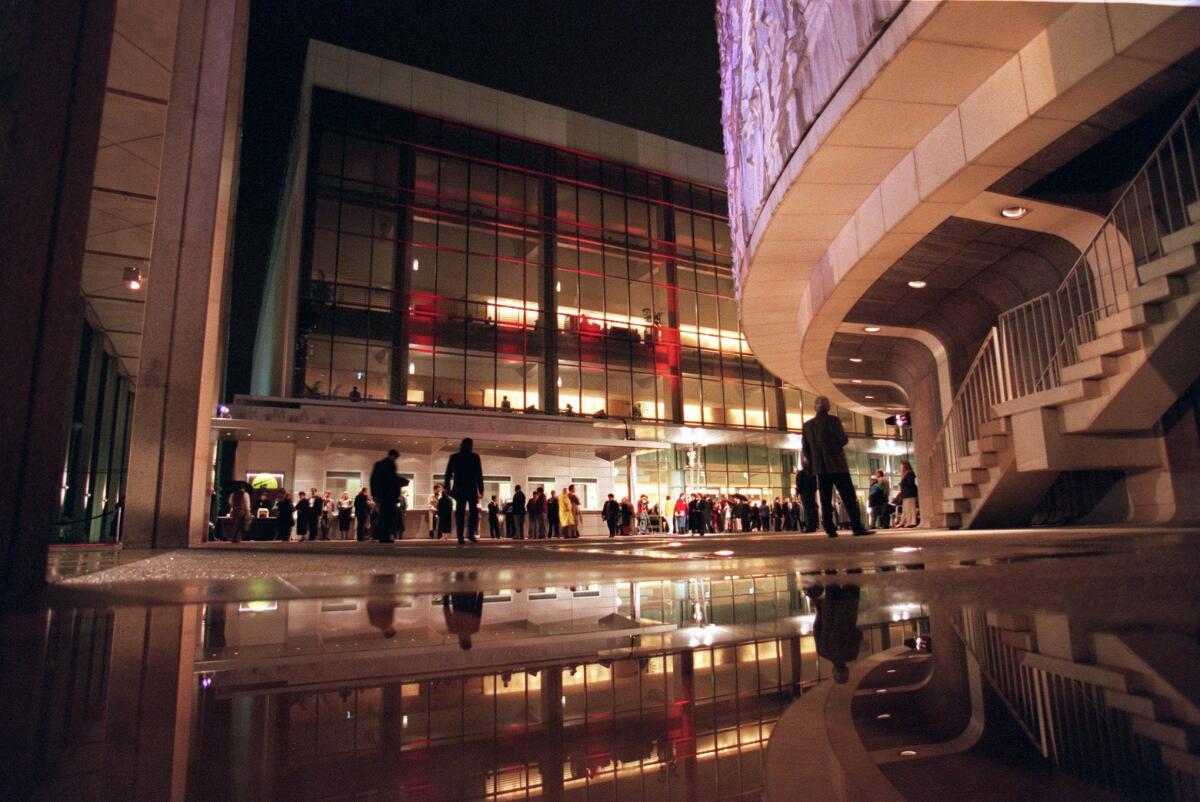Ambitious new work would help elevate Center Theatre Group

Taking stock of Center Theatre Group on the occasion of the Music Center’s 50th anniversary is a bit like trying to summarize an up-and-down marriage. So many reasons to leave, so many cherished moments making it impossible to go.
After the rudderless revival of Sebastian Barry’s “The Steward of Christendom” at the Mark Taper Forum in December, I lost faith in Los Angeles’ flagship theater. But then in February hope bloomed again with a deliriously fizzy staging of Christopher Durang’s “Vanya and Sonia and Masha and Spike.”
If the swoops of this roller-coaster ride have been extreme since Michael Ritchie took over as artistic director of Center Theatre Group in 2005, the fault cannot be laid entirely at his feet. This theatrical behemoth, a three-headed hydra consisting of the Ahmanson Theatre and the Taper at the Music Center and the Kirk Douglas Theatre in Culver City, has been beset with challenges, both internal and external, for at least the last decade.
The leadership transition between Gordon Davidson, the Taper’s founding artistic director, and Ritchie was bound to be tricky. The Taper, launched in 1967, was Davidson’s baby, and its mission of producing politically conscious American drama such as Tony Kushner’s “Angels in America” and Anna Deavere Smith’s “Twilight: Los Angeles, 1992” gave CTG a national identity that reflected Davidson’s values and commitments. He balanced the financial exigencies of the Ahmanson (a CTG venue he eventually took over in 1989) with his vision for the stage as a town hall for ideas and passions. No matter how marginal others might consider the theater in America to be, for Davidson it was and remains central to our sanity as a society.
Ritchie’s sensibility, more showman presenter than in-the-trenches producer, is not only markedly different but he’s operating in an era in which the old nonprofit business model has come undone. The Great Recession, not quite over for arts institutions, has only quickened the pace of commercialization.
Once the home to plays by Shakespeare, Shaw and August Wilson, the Ahmanson still manages to present Broadway’s best in top-flight productions (“The Scottsboro Boys,” “Sweeney Todd,” “South Pacific”). But the theater has undermined some of its prestige with cheerleading musicals and jukebox junk that could make the Hollywood Pantages look like the Ivory Tower.
A site in limbo
But it’s the Taper that has suffered the most in recent years, though more from neglect than from selling out. Ritchie took over the season after the Douglas opened its doors, an expansion that stretched resources and complicated the calculus of new play development and production. The Taper’s place in CTG’s producing landscape — less adventurous than the Douglas though more intimate and potentially more risk-taking than the Ahmanson — has relegated it in practice to limbo status.
The best of Center Theatre Group’s recent world premieres — Rajiv Joseph’s “Bengal Tiger at the Baghdad Zoo” (which was reprised at the Taper) and Jennifer Haley’s “The Nether” — have been launched at the Douglas, while the Taper has been a clearinghouse for Broadway drama (good, bad and indifferent), one-person-shows of variable merit and new plays that occasionally seemed as though no one was minding the literary store.
Ritchie should be commended for maintaining high standards of acting and design. “Vanya and Sonia and Masha and Spike” was better in Los Angeles than it was in New York, and though I don’t think the cavernous Ahmanson was the right environment for Horton Foote’s “The Trip to Bountiful,” the casting of Blair Underwood in the role that Cuba Gooding Jr. played on Broadway helped make this more than simply a glorious Cicely Tyson vehicle.
Bold stands have occasionally been taken. The cruel economics of Broadway were against a transfer of London’s Donmar Warehouse production of “Parade,” but the Taper gave this revival of Alfred Uhry and Jason Robert Brown’s deeply serious musical a U.S. home at a time when it was easy to forget that the American musical can think and sing at the same time.
A colleague complained to me recently about the reliance on revivals, but I’d like to see more productions of classics staged with the urgency of new work. Why did the Taper productions of “Waiting for Godot” and “Joe Turner’s Come and Gone” succeed to the extent that they did? Audiences are hungry for substantive drama presented with care by artists who have a connection to the material. (It’s worth underscoring that productions not commuting from or to New York or London have been some of the most successful during Ritchie’s tenure.)
I’m looking forward to seeing Joe Orton’s “What the Butler Saw” this month and Arthur Miller’s “The Price” early next year at the Taper. Would it be too much to ask for the occasional Ibsen, Shakespeare or Shaw at the Ahmanson? The stars don’t always align for revivals, but theatergoers know when they are being taken seriously and are likely to forgive the inevitable blunder when the artistic intentions are worth supporting.
If you treat audience members like consumers, they will be more than happy to grumble about the flawed merchandise. But if you make them feel like they’re patrons of an arts institution, they are more prone to respond with loyalty.
A freshening up
It would be thrilling to see the theaters working again in tandem, as they did when the Ebony Repertory Theatre revival of “A Raisin in the Sun” was being presented at the Douglas and the Playwrights Horizons production of “Clybourne Park,” Bruce Norris’ Pulitzer Prize-winning response to Lorraine Hansberry’s classic, was being produced at the Taper.
Ritchie was criticized early on for doing away with CTG’s minority play initiatives, arguing that they weren’t bearing fruit for production. I think his record of producing work by African American artists has been strong. I can’t say, however, that his regime has been especially adept at cultivating new plays.
CTG could use new blood in its literary department and perhaps someone to galvanize the Douglas with pathbreaking new ventures. But given the state of budgets these days, I have a couple of other suggestions that shouldn’t cost anything.
Ritchie enjoys being able to offer slots to artists he knows and respects. The upshot of this is that we’ve been treated to substandard David Mamet and Theresa Rebeck plays. Ritchie is hardly the only artistic director granting favor in this manner, but the practice at CTG is particularly dismaying when ambitious new work by Suzan-Lori Parks and Tony Kushner is being passed over along with Quiara Alegría Hudes’ Pulitzer Prize-winning “Water By the Spoonful,” a politically astute, emotionally resonant play that likely would have been snatched up by the Taper in its heyday.
More head-scratching still is the apparent lack of interest in the new generation of dramatists, perhaps the most exciting cohort of playwrights to come around in decades. These writers — Annie Baker, Tarell Alvin McCraney, Amy Herzog, Samuel D. Hunter, to name just a few — aren’t writing in a Broadway mode, but isn’t that what nonprofit theaters like the Taper were created for?
Ritchie has been criticized for not supporting local artists expressly writing about Los Angeles. But the bigger issue is that he’s not connecting his institution — and his audience — to those artists who are propelling the art form forward.
For CTG to remain vital during the Music Center’s next 50 years, it can’t afford to turn its back on the future that has already arrived.
Follow me on Twitter: @CharlesMcNulty
More to Read
The biggest entertainment stories
Get our big stories about Hollywood, film, television, music, arts, culture and more right in your inbox as soon as they publish.
You may occasionally receive promotional content from the Los Angeles Times.











